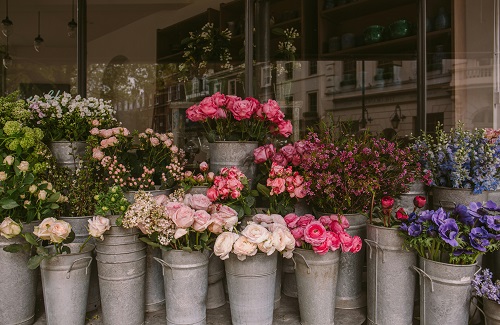Flower Shop

Type: Retail.
Key Products for Sale:
- Fresh Flowers: Offering a wide variety of seasonal blooms including roses, lilies, tulips, daisies, and orchids.
- Floral Arrangements: Handcrafted bouquets, centerpieces, and floral decorations for various occasions such as weddings, birthdays, anniversaries, and corporate events.
- Potted Plants: Indoor and outdoor plants, succulents, and bonsai trees for home and office decor.
- Gift Accessories: Complementary items like vases, ribbons, greeting cards, and gift baskets to accompany floral purchases.
Technology Considerations:
- Point of Sale (POS) System: Utilizing a POS system for inventory management, sales tracking, and customer transactions.
- Online Store: Developing a user-friendly website or mobile app for online orders, delivery services, and customer inquiries.
- Floral Design Software: Using specialized software for creating and visualizing floral arrangements to meet customer preferences.
- Social Media and Digital Marketing: Leveraging social media platforms and digital advertising to showcase products, attract customers, and promote special offers.
Market for the Products:
- Individual Customers: Individuals purchasing flowers for personal use, special occasions, or gifts.
- Event Planners: Professionals organizing weddings, parties, and corporate events requiring floral decor and arrangements.
- Businesses: Corporate clients seeking floral arrangements for office spaces, receptions, and special events.
- Funeral Homes: Providing sympathy flowers and arrangements for funerals and memorial services.
Key Inputs into the Business:
- Fresh Flowers: Sourced from local flower markets, growers, and wholesalers.
- Potted Plants: Purchased from nurseries or specialized suppliers.
- Floral Supplies: Vases, ribbons, foam blocks, and other floral accessories.
- Skilled Florists: Hiring experienced floral designers and staff to create arrangements and assist customers.
- Retail Space: Leasing or purchasing a storefront in a high-traffic area with good visibility and accessibility.
Product Preparation Process:
- Procurement: Sourcing fresh flowers, potted plants, and floral supplies from reliable suppliers.
- Floral Design: Creating customized arrangements based on customer preferences, occasion, and budget.
- Inventory Management: Regularly restocking inventory to ensure a diverse selection of fresh flowers and plants.
- Customer Service: Providing personalized assistance, advice, and recommendations to customers.
- Packaging: Carefully packaging floral arrangements and potted plants for safe transportation and delivery.
Quality Considerations:
Freshness: Ensuring the highest quality and freshness of flowers by sourcing from reputable suppliers and maintaining proper storage conditions.
Design Expertise: Employing skilled florists with a passion for floral design and creativity.
Customer Satisfaction: Focusing on excellent customer service, attention to detail, and exceeding customer expectations.
Longevity: Providing care instructions to customers to extend the lifespan of their floral purchases.
Cost of Investment:
Initial Inventory: between KES 50,000 to KES 100,000 (depending on the variety and quantity of flowers and plants).
Storefront Rent: between KES 30,000 to KES 100,000 per month (depending on location and size).
Equipment and Supplies: between KES 20,000 to KES 50,000 (including refrigeration, display racks, and packaging materials).
Staff Salaries: between KES 30,000 to KES 80,000 per month (depending on the number of employees and their experience).
Marketing and Promotion: between KES 10,000 to KES 30,000 (initial branding, signage, and advertising expenses).
Required Operational Infrastructure:
Retail Space: Leasing or purchasing a storefront with ample display space for showcasing flowers and plants.
Refrigeration: Installing refrigeration units to preserve the freshness of flowers and extend their shelf life.
Workstations: Provide workstations equipped with tools and supplies for floral arrangement and design.
Point of Sale System: Setting up a POS system for processing transactions and managing inventory.
Delivery Vehicle: If offering delivery services, invest in a delivery vehicle for transporting orders to customers.
Most Suitable or Viable Location of the Business:
High-Traffic Areas: Choosing a location in commercial districts, shopping centers, or tourist areas with high foot traffic.
Visibility: Selecting a storefront with good visibility and signage to attract passing customers.
Accessibility: Ensuring easy access and parking for customers, especially if offering delivery services.
Proximity to Event Venues: If targeting event planners and corporate clients, locating near event venues and business centers can be advantageous.
Potential Sources of Investment Capital:
Personal Savings: Investing personal funds or savings into the business.
Small Business Loans: Applying for loans from banks, credit unions, or microfinance institutions.
Investors: Seeking investment from private investors or venture capitalists interested in the floral industry.
Crowdfunding: Using online crowdfunding platforms to raise capital from individual backers.
Government Grants: Exploring grants and subsidies available for small businesses, particularly in the retail sector.
Requirements for Effective Management:
Floral Expertise: Hiring skilled florists with experience in floral design, customer service, and inventory management.
Business Management Skills: Developing a sound business plan, managing finances, and implementing effective marketing strategies.
Customer Relationship Management: Building strong relationships with customers, understanding their preferences, and providing personalized service.
Inventory Management: Implementing efficient inventory management practices to ensure a steady supply of fresh flowers and plants.
Staff Training: Providing ongoing training and development opportunities to employees to enhance their skills and performance.
Role of Mobile Phones and ICT in the Business:
Online Ordering: Allowing customers to place orders and make payments online through a website or mobile app.
Digital Marketing: Utilizing social media platforms, email marketing, and digital advertising to promote products and engage with customers.
Customer Communication: Using mobile phones and messaging apps for real-time communication with customers regarding orders, delivery status, and inquiries.
Inventory Management: Implementing inventory management software to track stock levels, monitor sales, and streamline reordering processes.
Pricing:
Competitive Pricing: Offering competitive prices based on market research and the quality of products and services.
Value-Based Pricing: Pricing arrangements are based on the value perceived by customers, especially for customized floral arrangements and premium services.
Seasonal Pricing: Adjusting prices based on seasonal fluctuations in demand and availability of flowers and plants.
Profitability:
Estimated Annual Profits: Depending on the location, scale, and efficiency of operations, annual profits can range from KES 500,000 to KES 2,000,000 or more.
Profit Margin: Aim for a profit margin of 20-30% by optimizing operational efficiency, minimizing costs, and maximizing revenue.
Next Steps to Take:
- Secure Funding: Obtain necessary funding through personal savings, loans, or investments to cover startup costs and initial expenses.
- Find a Suitable Location: Research and secure a retail space in a high-traffic area with good visibility and accessibility.
- Source Suppliers: Establish relationships with reliable suppliers for sourcing fresh flowers, plants, and floral supplies.
- Hire Staff: Recruit skilled florists and staff with a passion for customer service and floral design.
- Set Up Operations: Install necessary equipment, set up workstations, and implement inventory.

